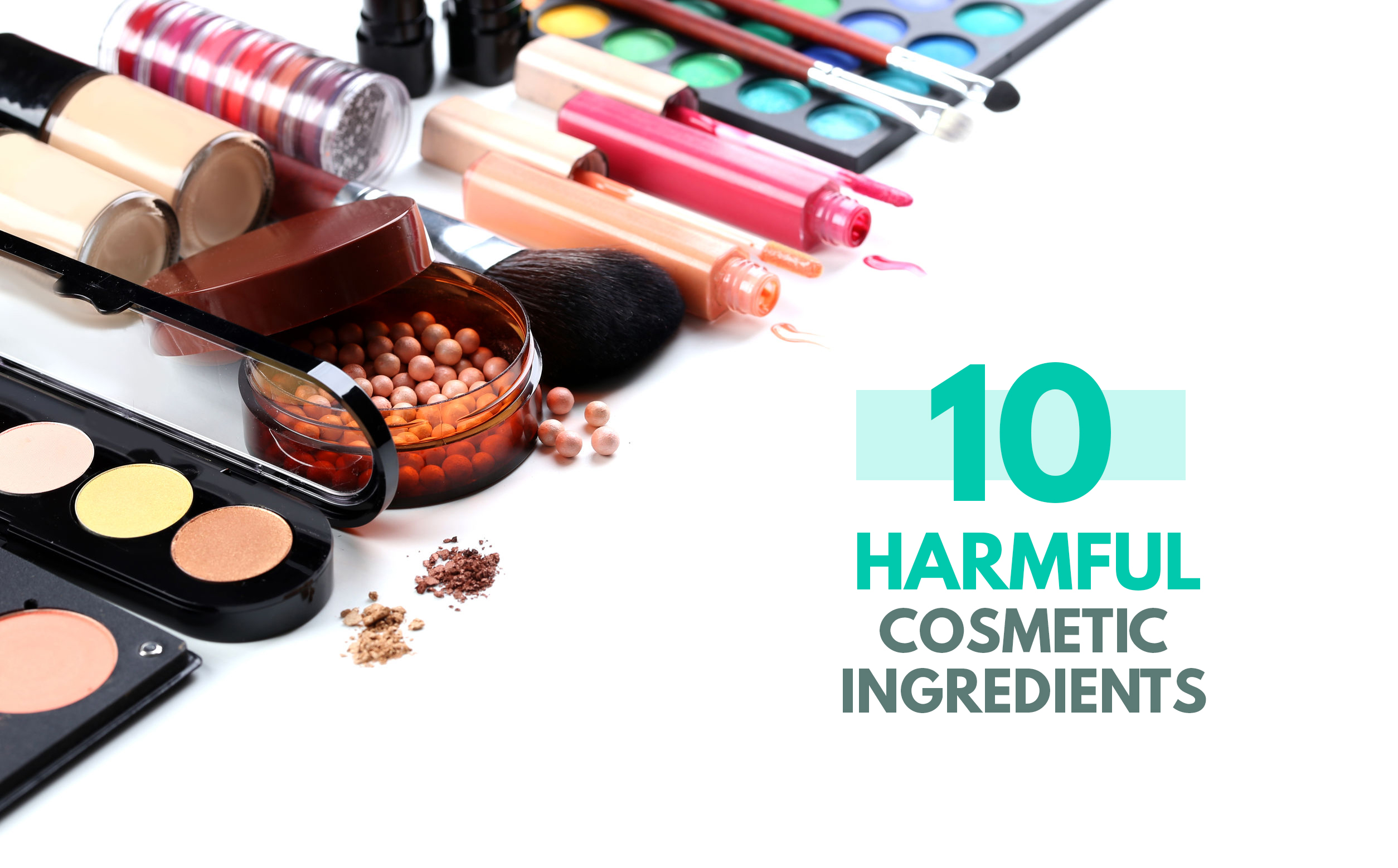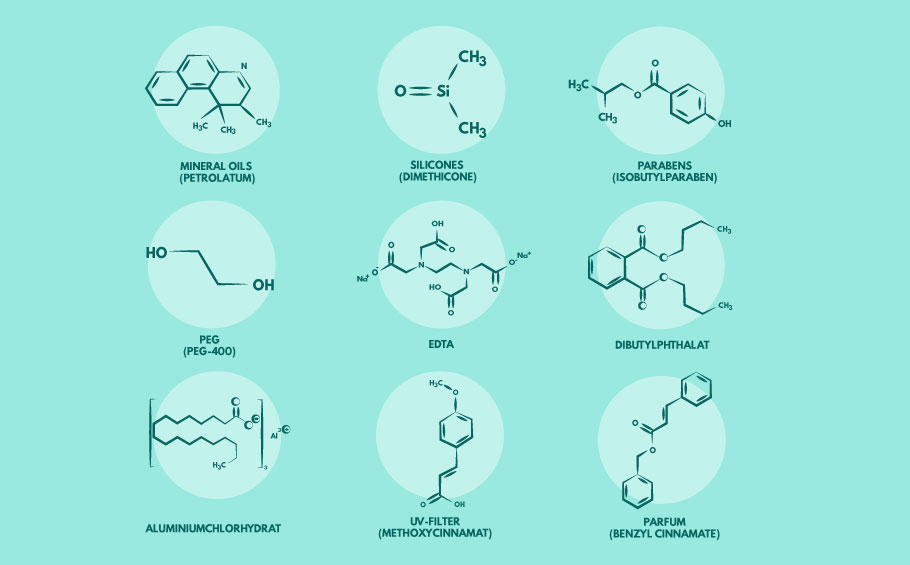
Face cream, deodorant, toothpaste, shampoo, nail varnish, perfume, aftershave and soap. Have you ever thought about how many cosmetic products you use a day? According to Cosmesicura (https://www.cosmesicura.org/i-cosmetici), on average, a man uses 7 products a day, while a woman uses up to 20. Learning to check labels so that we choose safe, long-lasting products which do not harm our skin is fundamental. So, what are we supposed to look out for? …
So, let’s be clear: when is an ingredient harmful?
Firstly, we should highlight that, following analysis or scientific studies, if an ingredient is defined as toxic to humans, the European Union prohibits it’s use or sets a maximum threshold.
The ingredients that we recommend you avoid are all those that, after frequent use, could damage our skin or hair, generally causing the onset of side effects, such as allergic reactions, blackheads or spots. Common terms such as "natural product" or "organic product" are often misleading as they’re not synonymous to green ingredients that are harmless to our health, animals, or the environment. Just think of a couple of famous products such as “Bio-oil”, promoted as a natural product; or “Johnson’s Baby Oil”, recommended for newborns. Both of the products’ lists of ingredients include Paraffin (Paraffinum Liquidum): an ingredient that comes from petrochemicals.
The first step? Learning to read INCI
In 1997, the European Union introduced the INCI law. It is the "International Nomenclature of Cosmetic Ingredients": an international regulation on the correct indication of ingredients in cosmetics [1].
- In compliance with the regulations, cosmetic manufacturers are obliged to write down all the ingredients and order them in descending order of concentration levels: the highest percentage at the top and the lowest at the bottom.
- Most ingredients are shown in English, except for botanical names and those present in the pharmacopoeia, which is shown in Latin.
- Artificial colours are identified by a code in the Colour Index (CI). For these ingredients, the CI number then becomes the INCI name (e.g. C1 77288). The only exceptions are hair dyes, which must always be shown in their English chemical name.
- Flavoured and fragrant compounds and their raw materials are indicated by the generic terms 'aroma' and 'parfum'. It is legally mandatory to show explicit indications of additional flavouring and aromatic substances that have been defined as potentially allergenic. They are indicated with their specific names, so referred to as "parfum" and "aroma".
- Natural ingredients from organic farming, on the other hand, are underlined with an asterisk on the INCI (*).
Which ingredients should be avoided?
1. Petrolatum
Petroleum products are hydrocarbons derived from oil and its refining. Those used in beauty products are defined as white, as they are purified. They are mainly used in creams, shampoos, bath foams and make-up, but also in some intimate shower gels. They are used as "filming agents": they form a sort of film on the skin, making it smoother. However, as they don’t allow the skin to breathe, they often cause pore closure or mucous and skin irritation. The most commonly used ones are:
- Paraffinum liquidum
- Mineral Oil
- Petrolatum
- Vaseline
- Microcrystalline wax
2. Silicone
Silicones are chemical substances: specifically, polymers, often used for their film-forming power in hair products, they give shine and smoothness. But really, they can progressively damage hair fibres or encourage the onset of skin impurities. The positive aspect is that many cosmetic industries are adapting to the demand of increasingly aware consumers, and so labels such as "silicone-free" on the front of products are becoming more common. To help recognize them you can check the for ingredients with the following endings: -thicone; -xiloxane; -silanoil.
The most common are:
- Amodimethicone;
- Dimethicone;
- Dimethiconol;
- Cyclomethicone;
- Cyclopentasiloxane;
- Trimethylsiloxysilicate;
3. Parabens
Parabens are chemical compounds with antibacterial and fungicidal properties. They are found in almost all beauty products because they promote the preservation of the products.
The most common are:
- Isobutylparaben
- Butylparaben
- Benzylparaben
- Isobutylparaben
- Isopropylparaben
4. I PEG - Polythylene Glycols
PEGs are water-soluble blood molecular compounds. Their raw material is ethylene oxide derived from petroleum. They are used in many cosmetics for their emulsifying power, i.e. the ability to bind oily and aqueous substances, or as surfactants, i.e. washing substances. They can be harmful in the long run because, by making the skin more permeable, they promote the absorption of substances, whether harmful or harmless. They are often indicated by the name "eth" or by the abbreviation PEG accompanied by a number, which represents the molecular weight. Those with a high number, e.g. PEG - 100, are the worst because it is more likely to contain toxic residues.
Some more frequent examples:
- Tensid Sodium Laureth Sulfate
- Peg - 400
- Laureth-9 (PEG 450)
- eteareth-33
- Ceteth-20

5. Phthalates
Phthalates are also oil-derived chemicals. They are used as plasticisers, solvents or to improve the consistency of various products. They are mainly used in nail polishes, perfumes and aftershave, but are also found in creams, shampoos and non cosmetic products of various kinds.
The types are:
- DINP - diisononyl phthalate
- DEHP - bis(2-ethylhexyl) phthalate
- DNOP - dioptyl phthalate
- DIDP - diisodecyl phthalate
- BBP - butylbenzyl phthalate
- DBP - dibutyl phthalate
6. Aluminium Salts
Aluminium Chloride salts are water-soluble compounds derived from aluminium that are used mainly in deodorants (but also in lipsticks or dentists) for their anti-breathable function. In fact, they form gelatinous protein complexes, which close the pores and inhibit sweating. A study by the German Federal Institute for Risk Assessment (BfR) has evaluated the intake of aluminium in "antiperspirants" such as deodorants. The result showed that the daily use of aluminium deodorants exceeds the tolerated dose indicated by the European Food Safety Authority (EFSA). To avoid them, be sure to buy products that do not contain the word "Aluminium" in the list of ingredients such as:
- Aluminium Chlorohydrate
- Aluminium Zirconium Tetrachlorohydrex Glycine
- Aluminium Zirconium Trichlorohydrex Gly
- Aluminium Stearate
- Aluminiumchlorohydrat (Aluminiumhydroxychlorid)
7. Sunscreen UV filters
Most sunscreens on the market contain chemical UV filters to protect us from the sun's rays. They are often a preference as opposed to mineral UV filters, because they make the cream spread better on the skin and leave no white traces. However, they can be highly harmful to our health. A study by the U.S. Food and Drug Administration (FDA), published in JAMA medical journals (https://jamanetwork.com/journals/jama/fullarticle/2733085), has shown that some of these do not stop at the skin, but enter the cardiovascular system and the body in less than 24 hours.
Examples of those to avoid are:
- Methoxycinnamate
- Octocrylene
- Benzophenone-3, -4, -5
- Ethylhexyl Salicylate
- Ethylhexyl Dimethyl
- Isoamyl Methoxycinnamate
8. Chemical Perfumes
Don't be fooled by the pleasant smell of most cosmetic products. They are referred to as "Parfum", without distinction between those that have a chemical or natural origin. Most of them, however, are nothing more than a chemical compound derived from oil, which, due to its low molecular weight, can go into the skin.
9. Ingredients of Animal Origin
Finally, let us not forget all those animal based products that are unfortunately widely used in cosmetic products. Keratin, which is mainly present in hair products, can come from the manes, feathers or horns of various animals. Hyaluronic acid, which is used mainly in skin care creams and as an anti-wrinkle agent, can come from the chicken’s combs. Stearic acid, often used in soaps, can come from lard (pig fat) or tallow (beef fat). Finally, the famous collagen that’s exclusively from animal origins; coming from slaughterhouses, bones, heads, tendons, cow cartilage, fish, calves or pigs. When it comes to Collagen products, we recommend you read our blog: (link to the blog)
10. The Compound Edta: Harmful for the Environment
Edta (ethylenediaminetetraacetic acid) is a chelating agent that retains the molecules of many heavy metals. It is widely used, not only in cosmetics, but also in food and medicine as it can neutralize the harmful effects of heavy metals. Though it is not directly harmful to health, it is bad for the environment. Being highly water-soluble, in fact, it does not completely dissolve during wastewater treatment and often stays in the waters of rivers and seas: it can then become bioavailable for fish and other animals.
Most common examples:
EDTA
HEDTA
TEA-EDTA
Disodium EDTA
Tetrasodium EDTA
Calcium Disodium
EDTA Diammonium
EDTA Dipotassium
So, where can you find information about the ingredients?
Fortunately, we do not have to remember everything by heart. The Internet helps us by offering various websites or apps, where you can check the list of ingredients.
We especially recommend https://www.biotiful.it/, which is also available as an app. It contains a database of more than 10,000 products and is updated daily. It is useful to check the ingredients of the products before buying, discovering their function and their evaluation. The App is very practical as you can check your products with a simple photograph of the ingredients.
For those who want to find out more by reading, we recommend some paper guides such as the book, "What's really in your cart? – A practical guide to food additives and cosmetic ingredients" by Bill Statham, Australian researcher, writer and publisher. Or "How cosmetics are made" by Giulia Pennazzi, pharmacist and specialist in cosmetic science and technology.
The Alternative: Natural Remedies
To conclude, remember not to trust labels such as "organic product", "natural product" or others. Learn to recognize the ingredients or even better, rely on DIY. There are many natural remedies, which are not only safer for our health, but often much cheaper and achievable with everyday ingredients. Rose water can be an excellent tonic for the face, and with ingredients that are easy to find, such as butter alternatives, cocoa butter and almond oil, you can make a cacao butter. Something even simpler? With coffee grinds and olive oil you can make a great body scrub (you’ll be surprised with the results on your skin!); and with a ripe banana, oatmeal and cinnamon, a moisturizing mask (which is of course also good to eat).
SOURCES
1] Official Journal of the European Union, Inventory and common nomenclature of ingredients used in cosmetic products, 2006 http://www.salute.gov.it/imgs/C_17_normativa_984_allegato.pdf
https://www.chemie-schule.de/KnowHow/Ethylendiamintetraessigs%C3%A4ure
https://www.macrolibrarsi.it/speciali/edta-nei-cosmetici-fa-male.php
https://www.cir-safety.org/ingredients
https://www.greenme.it/consumare/cosmesi/gli-ingredienti-piu-tossici-contenuti-nei-cosmetici/
https://www.bfr.bund.de/cm/343/aluminium-im-alltag-ein-gesundheitliches-risiko.pdf
https://www.greensurance.de/glossar/edta/
https://tg24.sky.it/salute-e-benessere/2019/05/09/creme-solari-sostanze-chimiche-sangue.html
https://www.lifegate.it/persone/stile-di-vita/breve_dizionario_degli_ingredienti_cosmetici_nocivi
https://www.alebshop.it/ingredienti-dannosi-nei-cosmetici/
https://ecocentrica.it/cosmetici-pericolosi-la-lista-e-la-guida-allinci/
https://www.gesundheitstabelle.de/index.php/schadstoffe-gifte/gifte-kosmetika
https://www.greenme.it/vivere/salute-e-benessere/ftalati/
https://link.springer.com/article/10.1007%2Fs00204-019-02599-z
https://ideamakeup.it/ingredienti-nocivi-cosmetici/
https://labiosophia.wordpress.com/2015/02/12/19/
https://www.dermaviduals.de//deutsch/publikationen/inhaltsstoffe/polyethylenglykole-co-von-wirkungen-und-nebenwirkungen.html
https://www.codecheck.info/hintergrund/kosmetika
https://www.geo.de/wissen/gesundheit/16724-rtkl-raetselraten-beim-kleingedruckten-versteckte-inhaltsstoffe-kosmetik-und
https://www.huffpost.com/entry/dangerous-beauty-products_b_4168587
https://www.altroconsumo.it/salute/cura-della-persona/consigli/cosmetici-come-sceglierli-sicuri
https://www.ideegreen.it/ingredienti-dannosi-nei-cosmetici-65832.html
https://www.alebshop.it/ingredienti-dannosi-nei-cosmetici/


